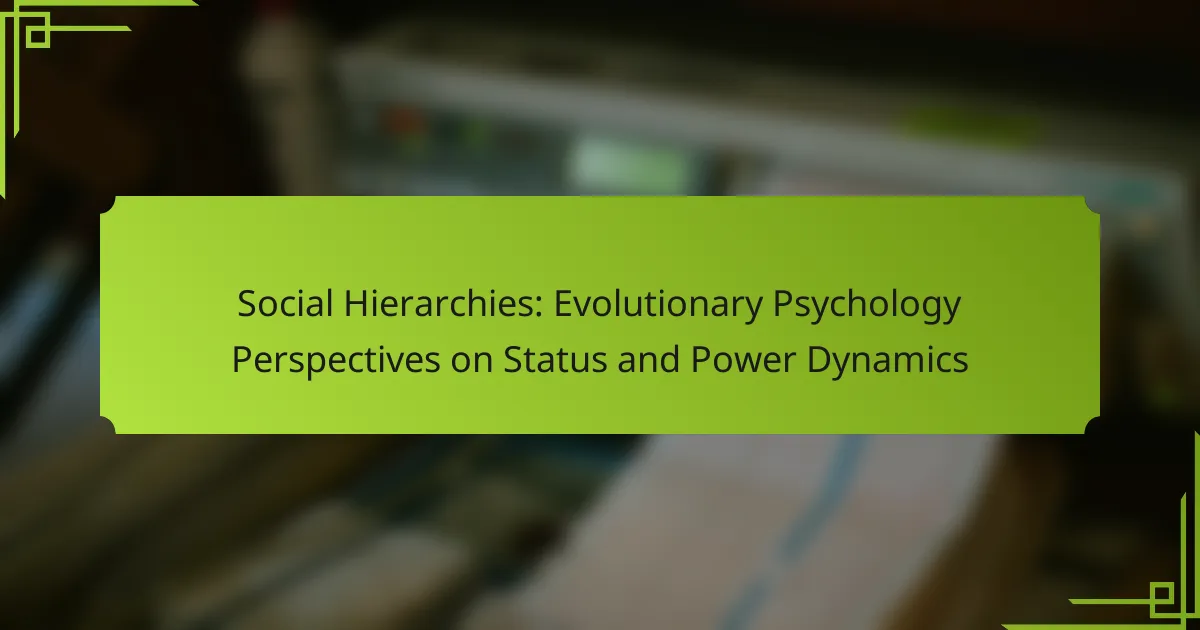Understanding social hierarchies is crucial for navigating power dynamics and status in various contexts. This article explores how evolutionary psychology shapes these hierarchies, the influence of competition for resources, and the role of social roles. It also examines different types of hierarchies, cultural perceptions of power, and effective communication strategies to foster inclusivity. Insights into these dynamics reveal the underlying motivations driving human interactions.

What are the foundational principles of social hierarchies in evolutionary psychology?
Social hierarchies in evolutionary psychology are shaped by competition for resources and mating opportunities. These hierarchies influence social behaviour, status, and power dynamics. Individuals in higher ranks often possess advantages like access to better resources and mates. Status can be established through various means, including aggression, cooperation, and social alliances. The unique attribute of social hierarchies is their adaptability to environmental changes, reflecting shifts in societal structures and norms. Understanding these dynamics helps explain human social interactions and the underlying motivations driving them.
How do social hierarchies influence individual behaviour?
Social hierarchies significantly shape individual behaviour by influencing social interactions and self-perception. Individuals often adjust their actions based on perceived status within a hierarchy, impacting decision-making and relationships. For example, higher status can lead to increased confidence and assertiveness, while lower status may result in submissive behaviour. Research indicates that these dynamics can affect group cohesion and individual mental health. Understanding these influences is crucial for fostering inclusive environments that mitigate negative impacts of hierarchical structures.
What role does status play in social interactions?
Status significantly influences social interactions by establishing power dynamics and group hierarchies. Individuals with higher status often receive more respect and influence, shaping their social experiences. Evolutionary psychology suggests that status plays a critical role in resource allocation and mating opportunities. This hierarchy affects communication styles, decision-making, and conflict resolution. People tend to align with those of similar or higher status, reinforcing social bonds and group cohesion. Understanding these dynamics can enhance interpersonal relationships and foster effective collaboration.
How is status perceived across different cultures?
Status is perceived differently across cultures, influenced by social hierarchies and power dynamics. In collectivist cultures, status often derives from group affiliation and familial ties, emphasizing harmony and community. In contrast, individualistic cultures prioritise personal achievements and self-reliance, where status reflects individual success.
Research shows that cultures with a high power distance, such as those in Asia, accept hierarchical structures, valuing respect for authority. Conversely, cultures with low power distance, like Scandinavian countries, promote egalitarianism, encouraging open dialogue across social levels.
Unique attributes of status perception include the role of age in some societies, where elders command respect, versus cultures where youth and innovation are celebrated. Additionally, rare attributes like gender dynamics can influence status, with some cultures assigning different roles and expectations based on gender.
Understanding these variations is crucial for navigating cross-cultural interactions, as misinterpretations of status can lead to conflicts or misunderstandings.
What are the psychological mechanisms behind power dynamics?
Power dynamics are influenced by psychological mechanisms such as social comparison, conformity, and authority. These mechanisms shape how individuals perceive their status and navigate social hierarchies. Social comparison drives individuals to evaluate their own status relative to others, often leading to competition for higher positions. Conformity reinforces power structures as individuals align their behaviours with group norms to maintain acceptance. Authority figures exert influence through perceived legitimacy, shaping group dynamics and individual responses. Understanding these mechanisms reveals the complexities of status and power in social settings.

What are the universal attributes of social hierarchies?
Social hierarchies universally exhibit attributes such as status, power dynamics, and social roles. Status often reflects an individual’s rank within a group, influencing access to resources and decision-making. Power dynamics encompass the ways individuals or groups assert influence over others, shaping interactions and relationships. Social roles define expected behaviours and responsibilities associated with one’s position in the hierarchy, guiding social interactions. These attributes are foundational in understanding how social structures evolve and function across different cultures.
How do hierarchies manifest in various social structures?
Social hierarchies manifest in various social structures through established power dynamics and status roles. These hierarchies often reflect evolutionary psychology, where dominance and resource control dictate social organisation. In many societies, status can be hierarchical, with clear distinctions between leaders and followers. For example, in corporate environments, managerial roles often represent higher status compared to entry-level positions.
Additionally, social hierarchies can be influenced by unique attributes such as cultural norms and economic conditions. In some communities, factors like education and wealth can create rare hierarchies that differ from traditional power structures. As a result, these hierarchies evolve, adapting to changes in societal values and behaviours.
What are the common benefits associated with social hierarchies?
Social hierarchies provide several benefits, including social cohesion, resource distribution, and conflict resolution. They establish clear roles, enhancing cooperation among group members. Additionally, hierarchies can facilitate decision-making, as leaders often possess greater experience or knowledge. As a result, these structures can promote stability and order within communities.
How do social hierarchies affect resource distribution?
Social hierarchies significantly influence resource distribution by establishing power dynamics that favour higher-status individuals. Higher social status often correlates with greater access to resources, such as wealth, education, and social connections. This unequal access can lead to systemic advantages for those at the top, reinforcing their status. For example, research in evolutionary psychology suggests that status can dictate not only material resources but also social opportunities, creating a cycle of privilege. As a result, lower-status individuals may struggle to attain similar resources, perpetuating inequality within societies.

What unique attributes distinguish different types of social hierarchies?
Different types of social hierarchies are distinguished by unique attributes such as the basis of status, power distribution, and the roles individuals play within the structure. For example, in a caste system, status is ascribed and fixed, while in a meritocracy, it is achieved based on individual performance. Additionally, hierarchies can vary in their rigidity; some are highly structured, limiting mobility, whereas others allow for greater fluidity. The unique attribute of social mobility is particularly significant in understanding how individuals can ascend or descend within these systems.
How does leadership style impact hierarchy effectiveness?
Leadership style significantly impacts hierarchy effectiveness by shaping communication, decision-making, and motivation. Authoritative leaders often foster clear structures, enhancing efficiency. In contrast, democratic styles encourage collaboration, which can improve morale and innovation. Research shows transformational leadership positively influences team dynamics, promoting adaptability and resilience. Effective leadership styles align with the organisation’s goals and the team’s needs, ultimately driving performance and cohesion in social hierarchies.
What are the unique traits of hierarchical systems in specific organisations?
Hierarchical systems in organisations exhibit unique traits such as defined authority structures, clear lines of communication, and role specialisation. These traits enhance efficiency and decision-making.
Defined authority structures establish power dynamics, allowing leaders to influence and guide subordinates effectively. Clear lines of communication facilitate information flow, ensuring that directives and feedback are efficiently exchanged. Role specialisation enables individuals to focus on specific tasks, increasing productivity and expertise within the hierarchy.
Moreover, the rigidity of hierarchical systems can create challenges such as resistance to change and limited innovation. As a result, organisations may struggle to adapt in rapidly evolving environments. Understanding these unique traits is crucial for navigating the complexities of power dynamics in social hierarchies.

What are the rare attributes found in social hierarchies?
Rare attributes in social hierarchies include unique leadership styles, exceptional adaptability to changing environments, and the ability to cultivate strong alliances. These traits can significantly influence an individual’s status and power dynamics within a group. For instance, a leader who exhibits transformative leadership may inspire loyalty and innovation, setting them apart from others. Additionally, rare social skills, such as emotional intelligence, can enhance interpersonal relationships, further elevating one’s position in the hierarchy.
How do exceptional cases of hierarchy challenge conventional wisdom?
Exceptional cases of hierarchy challenge conventional wisdom by revealing that power dynamics can be fluid rather than strictly defined. Traditional views often depict hierarchies as rigid structures, but instances like collaborative leadership or egalitarian movements illustrate that status can shift based on context and collective effort. These cases question the assumption that higher status always equates to greater influence, emphasizing the role of social cooperation and adaptability in determining power. This perspective aligns with evolutionary psychology, which suggests that social hierarchies are not merely about dominance but also about mutual benefit and resource sharing.
What historical examples illustrate rare hierarchical structures?
Historical examples of rare hierarchical structures include feudal systems and caste systems. Feudalism, prevalent in medieval Europe, established a rigid hierarchy with lords, vassals, and serfs, where land ownership dictated social status. Caste systems, notably in India, create a unique and enduring social stratification based on birth, limiting mobility and reinforcing social roles. These structures illustrate the complexity of power dynamics and status within societies, showcasing how historical contexts shape social hierarchies.

How do cultural perceptions of status and power vary globally?
Cultural perceptions of status and power differ significantly across the globe. In collectivist societies, status often derives from group affiliation and family connections, while in individualist cultures, personal achievements and autonomy are more valued.
For instance, in many Asian cultures, respect for elders reflects a hierarchical view of power, emphasizing age and experience. Conversely, Western cultures may prioritise meritocracy, where power is linked to individual accomplishments.
Additionally, the concept of power can be fluid; in some cultures, it is associated with wealth, while in others, it may stem from spiritual or communal leadership. Understanding these variations enhances cross-cultural communication and collaboration.
What are the implications of social hierarchies for community dynamics?
Social hierarchies significantly influence community dynamics by shaping interactions, resource distribution, and social cohesion. These hierarchies can create power imbalances, affecting group decision-making and individual well-being. For example, individuals in higher status positions often access better resources and opportunities, leading to enhanced group stability. Conversely, lower-status individuals may experience marginalisation, which can result in conflict or disengagement. Understanding these dynamics is crucial for fostering inclusive communities and addressing social inequalities.
How do social hierarchies influence conflict resolution?
Social hierarchies significantly shape conflict resolution by establishing power dynamics and influencing negotiation strategies. Higher status individuals often dominate discussions, while lower status individuals may feel marginalised. This power imbalance can lead to conflicts being resolved in favour of those with greater authority. For example, in organisational settings, leaders may impose solutions that reflect their status, potentially overlooking the perspectives of subordinates. Additionally, social hierarchies can affect the willingness of individuals to voice dissent, impacting the overall resolution process. Understanding these dynamics is crucial for fostering equitable conflict resolution strategies.

What best practices can enhance understanding of social hierarchies?
To enhance understanding of social hierarchies, focus on clear communication, active listening, and fostering inclusivity. These practices help individuals navigate power dynamics effectively.
Encourage open discussions about status and roles, which can demystify hierarchy and promote transparency. Utilizing visual aids, like charts or diagrams, can clarify complex relationships within hierarchies.
Training programmes that emphasise emotional intelligence can also improve interpersonal interactions, making it easier to recognise and respect different social positions.
Lastly, regular feedback mechanisms allow individuals to voice their experiences and perceptions, contributing to a more equitable understanding of social structures.
What common mistakes should individuals avoid in navigating social hierarchies?
Individuals should avoid being overly assertive, failing to recognise social cues, and neglecting relationship building. Overconfidence can alienate peers and hinder collaboration. Misreading social signals may lead to misunderstandings, while prioritising genuine connections fosters trust. Recognising the unique attributes of different social contexts enhances adaptability.
How can one effectively leverage their position within a hierarchy?
To effectively leverage a position within a hierarchy, one should focus on building relationships and demonstrating competence. Establishing trust with peers and superiors enhances influence and collaboration. Understanding the dynamics of power can guide strategic interactions. Adapting communication styles to suit different stakeholders fosters better engagement. Recognising the unique attributes of one’s position allows for targeted contributions that align with organisational goals.
